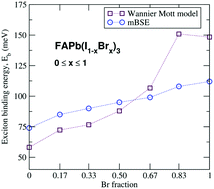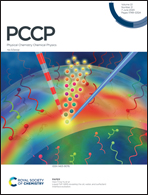Tunable relativistic quasiparticle electronic and excitonic behavior of the FAPb(I1−xBrx)3 alloy
Abstract
We study the structural, electronic, and excitonic properties of mixed FAPb(I1−xBrx)3 0 ≤ x ≤ 1 alloys by first-principles density functional theory as well as quasiparticle GW and Bethe Salpeter equation (BSE) approaches with the inclusion of relativistic effects through spin orbit coupling. Our results show that the system volume decreases with increasing Br content. The quasiparticle band gaps vary from 1.47 eV for pure α-FAPbI3 to 2.20 eV for Br-rich α-FAPbBr3 and show stronger correlation with the structural changes. The optical property analysis reveals that the overall excitonic peaks are blue shifted with the Br fraction. Our results further reveal strong Br concentration dependence of the variation in the exciton binding energy (from 74 to 112 meV) and the carrier effective masses as well as the high frequency dielectric constants. These findings provide a way to tune the carrier transport properties of the material by doping, which could be utilized to improve the short circuit currents and power conversion efficiencies in multijunction solar cell devices.



 Please wait while we load your content...
Please wait while we load your content...